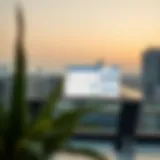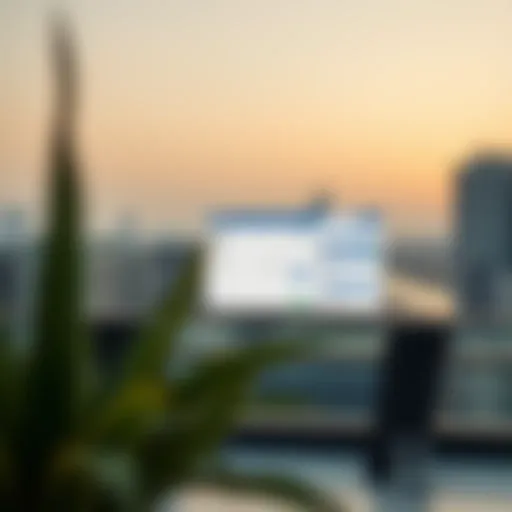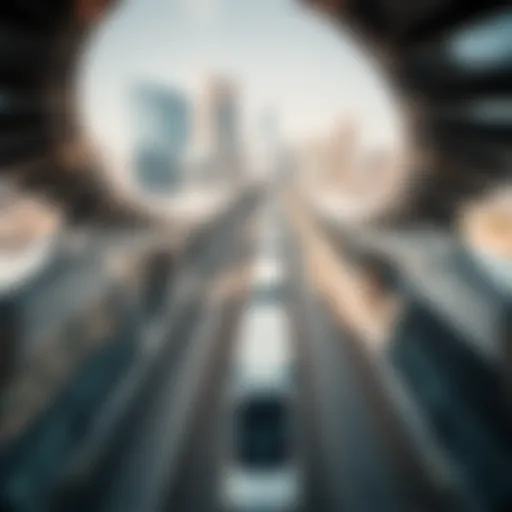Skyscrapers in Dubai: Shaping Real Estate Futures
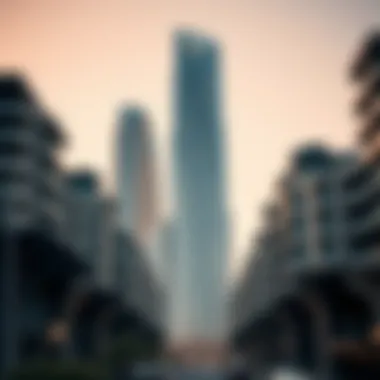

Intro
Dubai, a city that seems to touch the sky with its ambitious high-rises, is more than just a transit point between East and West. Its property market, particularly concerning skyscrapers, is a fascinating intersection of architectural ingenuity and economic vitality. A melange of cultures and investments, skyscrapers symbolize both the dreams of their creators and the ambitions of a diverse populace. Throughout the years, the skyline of Dubai has morphed into an iconic panorama, with structures like the Burj Khalifa and the Burj Al Arab leading the charge.
The sheer audacity of building upwards speaks to a real estate market that has been anything but conventional. This piece aims to explore the evolution of these towering giants and their future implications for investors, buyers, and urban planners alike.
Property Market Overview
Current Market Trends
The skyscraper scene in Dubai is ever-evolving, reflecting broader market trends. With the end of 2023 nearing, investory interest is shifting. Several factors are influencing this. One key observation is the increasing demand for mixed-use developments. Buyers today are not just looking for residential spaces; they want environments that offer a blend of living, working, and recreational opportunities.
Moreover, innovations in sustainability are becoming prevalent. Developers are exploring greener approaches. This shift isn't just a trend but a necessity in a world increasingly aware of climate change's importance. You'd find new designs integrating smart technologies, from wind turbines to energy-efficient materials. Such features not only attract environmentally-conscious buyers but also enhance the property's long-term value.
Key Neighborhood Insights
When discussing specific neighborhoods, areas like Downtown Dubai and Dubai Marina stand out with their high-rise distinctions. Downtown offers a blend of luxury and accessibility, housing a high number of residential skyscrapers and commercial hubs. On the other hand, Dubai Marina provides waterfront living that's hard to resist, attracting a younger demographic, especially expatriates eager for a vibrant lifestyle.
In contrast, Al Quoz and Business Bay are climbing the ranks due to their strategic locations and competitive pricing. These areas are increasingly appealing to investors looking for growth as they provide development opportunities amidst the city’s rapid expansion.
"Dubai's real estate market is a vibrant tapestry, woven from ambition, culture, and innovation, forever challenging the bounds of possibility."
Buying and Selling Guidelines
Essential Steps for Buyers
Navigating the skyscraper market can be tricky, especially for first-time buyers. Here’s a simplified guide:
- Do Your Homework: Research location and amenities. Check key factors that might affect property value.
- Consult Experts: Engage with real estate agents familiar with the local market. Their insights can save time and headaches.
- Check Legalities: Ensure all paperwork is in order. This isn’t just about the property but also about understanding any regulations.
- Inspect Properties: Always visit before making decisions. Pictures can be deceiving.
- Consider the Future: Think about the long-term value. Is the area expected to grow?
Tips for Sellers
For those looking to sell their skyscraper properties, a few strategies can enhance appeal:
- Stage the Property: A well-presented property can drastically affect buyer perception.
- Highlight Unique Features: If there is an amazing view or energy efficiency, make sure those details are front and center.
- Be Prepared to Negotiate: Flexibility can often seal the deal.
- Market Effectively: Utilize social media and real estate platforms vigorously. This ensures broad exposure.
In a city like Dubai, where the future feels like it could be built today, understanding the nuances of the skyscraper market is crucial for anyone looking to invest or sell. As more waves of innovative architecture redefine the skyline, the implications for urban development and property values will remain significant.
Prologue to Skyscrapers in Dubai
When you think of Dubai, its iconic skyline peppered with towering structures likely springs to mind. Skyscrapers are much more than just tall buildings; they represent ambition, innovation, and the very essence of modern urban living. Understanding the introduction to skyscrapers in Dubai gives a comprehensive view into how this vibrant city has carved its niche in the global real estate market.
The allure of Dubai's high-rises is tied to its rapid transformation from a modest fishing village to a global metropolis. Skyscrapers like the Burj Khalifa, the tallest building in the world, symbolize the city’s remarkable growth and its commitment to architectural excellence. Investors, buyers, and developers alike must comprehend the factors driving this development, as the skyline continues to evolve, shaping not only the physical landscape but also the economic and social dynamics within the emirate.
The benefits of skyscrapers in the region are multifold. Firstly, they maximize limited land space, crucial in a bustling city where every square foot counts. Secondly, these high-rises offer luxurious residences and commercial spaces, attracting both local and international investors who see Dubai as an opportunity not just for living but also for business.
Meanwhile, considerations around sustainability and innovation have increasingly become a part of the conversation, propelling the future of skyscraper design and construction. This article aims to delve deep into various aspects of these towering structures, from their historical context to the latest trends that will influence Dubai’s real estate landscape in years to come.
In this journey, we will explore both the remarkable architectural innovations and the market dynamics shaping this sector, aiming to equip stakeholders with valuable insights that extend beyond mere observance of the skyline.
Architectural Innovations in Skyscrapers
When we talk about the skyscrapers in Dubai, it’s not just their height that sets them apart; it’s the groundbreaking innovations in their architecture. The significance of architectural innovations is multifaceted and plays a crucial role in shaping the identity of Dubai's skyline and its real estate market. These innovations address various challenges, enhance functionality, and give a nod toward sustainability while providing a unique aesthetic that attracts investors and tourists alike.
Modern Design Principles
The modern design principles guiding skyscraper construction transcend traditional architecture. They incorporate a blend of aesthetic appeal and functional design. Minimalism, with its emphasis on clean lines and open spaces, drives many contemporary skyscraper projects. Take, for example, the concept of adaptability; these structures aren't merely fixed edifices. Builders now design skyscrapers with flexible interior layouts that can evolve with changing market demands. This adaptability bolsters the value of such properties, making them appealing to investors looking for longevity and resilience in their investments.
Another key principle is integration with the environment. Architects are increasingly considering the natural surroundings when designing these superstructures. This involves not just maximizing views but also blending the buildings into the landscape, making them harmonious additions to the urban fabric of the city. The result? A skyline that is not only a feast for the eyes but also ecologically sensitive.
Sustainable Architecture
Sustainable architecture in skyscrapers has emerged from urgent global conversations about climate change and urban sustainability. In Dubai’s real estate market, where the temptation to build towering heights meets the need for eco-consciousness, sustainable architecture becomes more than just a trend; it's a necessity.
Energy-Efficient Features
One specific aspect contributing to sustainable skyscrapers is energy-efficient features. These elements significantly reduce a building's carbon footprint while decreasing operational costs. Features such as high-performance glazing, enhanced thermal insulation, and solar panels play an integral role. Why are these popular choices? They provide not only environmental benefits but also financial savings in the long run.
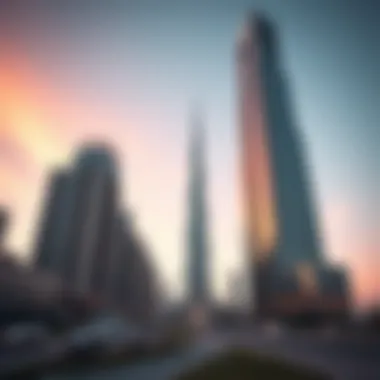

For instance, a skyscraper equipped with solar panels can harness renewable energy, thus offsetting energy costs and contributing to the grid. But there’s a catch: initial investment in these systems can be steep. That said, the payback period generally shortens with advancements in technology and rising energy prices.
Green Materials
Another vital component of sustainable architecture is the use of green materials. These materials, often sourced from recycled or sustainably harvested origins, minimize environmental impact. Utilizing materials like recycled steel, bamboo, or low-VOC concrete is becoming common practice.
The key characteristic of green materials is their ability to reduce waste and energy consumption during production. This is a highly beneficial move towards responsible development in a rapidly growing city like Dubai. However, it is worth noting that not all materials are economically feasible for every project, which could limit their widespread implementation.
Water Conservation Techniques
In a desert city, water is arguably more precious than gold. Therefore, water conservation techniques in skyscrapers are pivotal. Technologies like greywater recycling and rainwater harvesting systems are not just innovative; they are essential for sustainability. The idea is to treat and reuse water for non-potable purposes, such as irrigation and flushing toilets.
The major benefit of these techniques lies in their capacity to significantly reduce water consumption, making buildings in Dubai far less reliant on external resources. Still, challenges remain, particularly regarding the initial costs and infrastructural changes required for their integration.
Investing in skyscrapers that incorporate modern design principles and sustainable architecture can be a responsible choice for future-facing investors. The balance of aesthetics, function, and sustainability sets a new standard in Dubai's ever-evolving real estate landscape.
Market Dynamics of Skyscraper Developments
The dynamics of the skyscraper market in Dubai represent a confluence of various factors that influence how buildings are conceptualized, financed, and ultimately constructed. An understanding of these market dynamics is crucial for stakeholders, including investors, developers, and urban planners, as they provide insights into emerging trends and the future trajectory of high-rise structures in this bustling metropolis. The allure of the skyscraper isn’t just in its height; it's deeply rooted in the economic, cultural, and technological transformations that Dubai is undergoing.
Supply and Demand Pressures
The real estate market in Dubai is characterized by a constant tug-of-war between supply and demand. This balance—or imbalance—affects pricing, investment strategies, and development timelines. In recent years, Dubai has seen a boom in high-rise development fueled by its position as a global business hub and a tourist destination. However, builders must juggle these ambitions against market realities.
- High Demand for Space: As the population continues to grow and more businesses set up shop in the UAE, the demand for residential and commercial space in skyscrapers remains robust. This insatiable appetite for vertical living has driven developers to push the envelope further, leading to projects like the Observation Deck at Burj Khalifa, which attracts millions each year.
- Supply Constraints: While demand may boom, supply isn’t always a straightforward issue. Government regulations, land availability, and the complexities of high-rise construction can hamper development. Projects may often take longer than expected, leading to temporary oversupply in some market segments, which can pressure prices downward. This interplay between supply issues and demand fluctuations must be closely monitored by investors and developers.
Investment Trends and Forecasting
The investment landscape surrounding skyscrapers has evolved significantly. There is a visible shift toward understanding the longer-term implications of such structures—both good and bad. Investors looking at Dubai’s skyline are now considering which type of buildings offer the best potential returns.
Residential vs. Commercial Skyscrapers
When talking about skyscrapers, it’s essential to realize that they serve diverse purposes. The ongoing debate between the benefits of residential versus commercial skyscrapers has its roots in investor preferences and the overall economic context of Dubai.
- Key Characteristic: Residential skyscrapers often embody luxury and exclusivity, appealing to affluent individuals looking for a high-end living experience. In contrast, commercial skyscrapers focus on functionality and income generation, targeting businesses looking for prime office space. This diversity allows for tailored investment strategies.
- Unique Features and Trade-offs: Residential towers often attract higher rental yields due to the premium associated with living in prestigious locations, but they also come with risks, such as cost overruns during construction. Commercial skyscrapers, while typically having longer lease terms and predictable cash flow, can suffer in economic downturns when companies downsize or close shop.
Luxury High-Rises
The luxury market in Dubai has exploded over the last decade, with luxury high-rises setting trends not only locally, but also internationally. Luxury high-rises offer a unique blend of lavish amenities and prime locations that appeal to wealthier investors.
- Attractiveness: One of the key characteristics of luxury high-rises is their focus on lifestyle—think of amenities like infinity pools, state-of-the-art fitness centers, and private concierge services. These features make such properties highly sought after.
- Advantages and Disadvantages: While these properties can command significantly higher prices per square foot, their success is often tied to the health of the luxury market and global economic conditions. The challenge of maintaining exclusivity while ensuring sufficient demand is vital for long-term success.
Co-Working Spaces
The rise of the gig economy has led to a new player in the skyscraper game: co-working spaces. These modern facilities accommodate smaller businesses, freelancers, and start-ups in skyscraper environments, lending a fresh spin to traditional office environments.
- Key Characteristic: Co-working spaces focus on flexibility, allowing users to rent office space according to their needs—be it hourly, daily, or monthly. This dynamic environment offers networking opportunities and resource sharing.
- Benefits and Drawbacks: The main advantage of these spaces lies in their ability to attract a mix of clients without the long-term commitments often required for traditional leases. However, they can also face challenges, such as economic downturns where companies are looking to cut costs, impacting overall occupancy rates.
In essence, as Dubai’s skyline continues to evolve, so too will the market dynamics surrounding skyscraper developments. Investors must remain vigilant and adaptable, while developers navigate supply and demand pressures to create spaces that align with future trends.
Regulatory Framework and Building Codes
The regulatory framework and building codes play a pivotal role in shaping the landscape of skyscraper development in Dubai. As the emirate continues to evolve, these regulations are crucial for ensuring the sustainability, safety, and functionality of high-rise structures. They affect everything from the design and construction process to ongoing operations and management.
Understanding Local Regulations
Dubai's regulatory environment for skyscrapers is multi-layered, reflecting the city’s rapid growth and aspiration to be a global hub. Important organizations like the Dubai Municipality and the Dubai Land Department have established comprehensive guidelines that govern building heights, land use, and environmental sustainability. Local regulations dictate not only what can be built but also how it should be built. This includes zoning laws that can determine the purpose of a building. For instances, certain zones are allocated for commercial, while others may focus on residential developments.
Key Elements of Local Regulations:
- Zoning Laws: These dictate the height and type of structure permitted in specific areas.
- Environmental Considerations: With growing concerns about global warming, regulations are adapting to include sustainability requirements.
- Public Safety Standards: Guidelines ensure that buildings are safe for both future residents and pedestrians. This often includes spacing regulations to prevent overcrowding.
The interconnectedness of these regulations means that developers must conduct extensive research and stringent planning. A vital aspect here is the requirement for obtaining permits, which can be a lengthy process involving multiple stakeholders.
Safety Standards in High-Rise Construction
Safety standards are non-negotiable in the skyscraper construction sector. Given the complexities involved in building such towering structures, rigorous protocols have to be adhered to. These standards are set not only to protect potential occupants but also workers involved in the building phase.
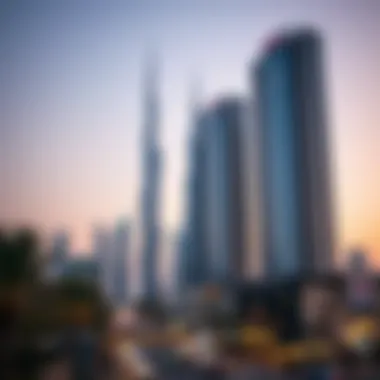

Key Safety Standards Include:
- Fire Safety Regulations: Buildings must incorporate fire-resistant materials and have adequate fire alarms and exits. The Fire and Life Safety Code in Dubai mandates that every skyscraper is fitted with state-of-the-art fire suppression systems.
- Structural Integrity: Regular inspections and adherence to engineering standards ensure that buildings can withstand phenomena like earthquakes and high winds.
- Accessibility: Compliance with the UAE laws for people with disabilities is essential. This includes elevators that accommodate wheelchair users and accessible entrances.
“In today’s climate, a thorough understanding of safety standards is paramount. Any oversight can lead to dire consequences, both financially and ethically.”
In summary, the regulatory framework and building codes in Dubai's real estate market are indispensable. They not only ensure the economic viability of high-rises but also affect their social impacts, shaping them into integral parts of the urban landscape.
Socioeconomic Impacts of Skyscrapers
The development of skyscrapers in Dubai isn't just about creating tall buildings; it’s a game changer for the socioeconomic landscape of the city. Skyscrapers act as catalysts for growth by attracting investments, creating jobs, and enhancing urban infrastructure. Their very presence signifies progress and modernization, which appeals to both local and international investors.
Urban Development and Population Growth
Skyscrapers have spurred urban development unlike anything we’ve seen in other parts of the world. They encourage higher density living which is crucial in a region with a booming population. As of recent years, Dubai has seen notable population growth, partly driven by job opportunities in various sectors such as tourism, finance, and hospitality. When skyscrapers sprout, they create surrounding ecosystems— retail spaces, restaurants, and leisure facilities that benefit the area’s residents. This increased density promotes community engagement and allows for a vibrant urban lifestyle.
"Without skyscrapers, the skyline of Dubai would look dramatically different, akin to a blank canvass without any vibrant strokes of color."
However, there are challenges to consider with such rapid development. As the population increases, so do demands on infrastructure, including transportation and utilities. Balancing growth with sustainability is crucial to ensure that urban sprawl doesn’t overcrowd the existing systems.
Cultural Identity and Landmarks
The cultural narrative of Dubai has been profoundly shaped by its skyscrapers. These architectural marvels serve as landmarks, instilling a sense of pride among locals while offering a unique identity to tourists.
The Burj Khalifa's Role
The Burj Khalifa stands tall not only as the tallest building but also as a symbol of ambition and innovation. Completed in 2010, it reshaped the skyline and became an essential part of Dubai's identity. It's more than just an observation deck; it represents the relentless pursuit of excellence that Dubai embodies. This building attracts millions of visitors each year, significantly boosting tourism. The key characteristic of The Burj Khalifa is its impressive height, drawing architectural enthusiasts, which perpetuates its popularity and financial benefit to the surrounding area.
In addition, the Burj Khalifa helps promote local businesses and fosters a thriving tourism economy. However, its iconic status brings with it the burden of maintenance and operational costs that local authorities must address.
Symbolism in Architecture
Symbolism in architecture conveys messages beyond aesthetics. The soaring heights of skyscrapers, such as the Burj Khalifa, reflect aspirations and future potential while emphasizing themes of growth and connectivity in urban life. This symbolism plays a crucial role in how investors and the public perceive Dubai. The unique designs of these skyscrapers evoke a modern lifestyle, thus making them attractive for real estate investors.
The potential downside is that, as these buildings become cultural symbols, they risk alienating some local populations who may feel disconnected from the luxury and opulence portrayed. Balancing these symbols with inclusive community planning is thus vital to ensure that the narrative of growth is beneficial for all residents.
The Role of Technology in Skyscraper Construction
The construction of skyscrapers in Dubai is not just about creating towering structures; it's about the integration of advanced technology that enhances efficiency, safety, and sustainability. Technology's role in skyscraper construction is pivotal, reflecting the aspirations of a rapidly evolving real estate market and catering to a demanding urban population. As the skyline of Dubai continues to transform, the construction techniques and technologies being employed are as much a part of the narrative as the buildings themselves.
Construction Techniques and Materials
Modern skyscrapers in Dubai leverage innovative construction techniques and materials that allow for taller and more complex designs than ever before. One prominent method is the use of reinforced concrete and steel frameworks, which provide the necessary strength without compromising on design flexibility. The increased use of precast concrete panels streamlines the construction process, allowing sections of buildings to be created in a controlled environment and then assembled on-site.
Advanced machinery, such as cranes that can hoist massive loads high into the sky, has revolutionized how we build. In some cases, robots are being utilized in the construction process. These machines deliver precise results and reduce the labor costs associated with manual labor.
Smart Building Technologies
With the push for sustainability and efficiency, smart building technologies have emerged as essential tools in modern skyscraper design. These technologies not only enhance the experience of the occupants but also significantly reduce the operational costs of the buildings.
Digital Integration
Digital integration is a cutting-edge aspect of smart building technologies. It encompasses various digital systems that work together seamlessly to optimize building operations. One of its key characteristics is the ability to connect different building systems—HVAC, lighting, security—into a single platform. This integration is increasingly seen as a prominent choice for skyscrapers because it enables real-time monitoring and control.
The unique feature of digital integration lies in its capacity for data analytics, which empowers building managers to make informed decisions. By examining patterns in energy usage or occupancy, they can enhance efficiency and comfort, ultimately leading to significant cost savings. However, the complexity of implementation can be a challenge, as it requires advanced infrastructure and ongoing maintenance.
Building Management Systems
Building Management Systems (BMS) serve as the brain of modern skyscrapers, controlling and monitoring all infrastructure systems. One of the standout aspects of a BMS is its ability to improve energy efficiency, a critical concern in today's environmental climate. These systems allow a centralized control that can adjust lighting, heating, ventilation, and air conditioning based on usage patterns.
What makes BMS a popular choice is their capability to continuously improve building operations based on feedback. Each skyscraper can be tailored according to its specific needs, enhancing user experience while reducing energy consumption. A downside, however, is the initial investment required for such comprehensive systems, which may deter some investors.
"Embracing advanced technology in skyscraper construction is not just an option; it’s a necessity for future-proofing urban development in Dubai."
In summary, technology plays a crucial role in the construction of skyscrapers in Dubai. From innovative materials and techniques to smart building systems that redefine the occupant experience, the evolution remains tied closely to advancements in technology. As Dubai aims for greater heights, both literally and figuratively, the integration of technology into construction processes will continue to shape the urban landscape.
Challenges Facing Skyscraper Developments
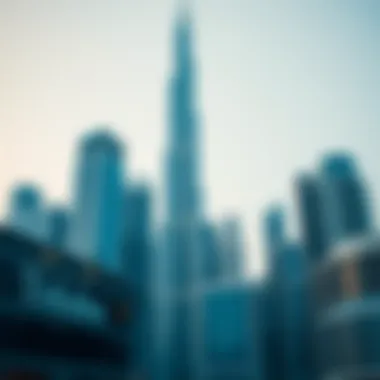

The construction and development of skyscrapers in Dubai face several hurdles that could influence the future of the real estate market. These challenges not only affect planning and investment decisions but also contribute to the dynamic nature of urban planning in a city renowned for its innovative skyline. Understanding these issues is essential for various stakeholders, including investors, buyers, and developers, as they navigate the complexities of this ever-evolving market.
Economic Fluctuations
Economic fluctuations present a significant challenge within the skyscraper development sector. Dubai's economy, with its heavy reliance on tourism and international business, can be sensitive to global market shifts. Sudden downturns, like those witnessed during the 2008 financial crisis or more recently due to the pandemic, can dramatically affect demand for high-rise properties. Investors may be wary of committing to new developments if economic indicators suggest an unstable future.
Furthermore, the cost of materials and labor can skyrocket, impacting project budgets adversely. Tightening margins often lead developers to contemplate compromises on quality or scale, which may affect long-term sustainability goals. As potential investors weigh their options, they must remain vigilant about market trends and economic signals that could indicate the right time to invest or proceed with construction.
Environmental Concerns
Environmental issues are becoming increasingly difficult to ignore as skyscrapers continue to reach for the skies. With stringent regulations being introduced globally, and growing awareness around sustainability, developers in Dubai face mounting pressure to design buildings that do not just look impressive but also minimize negative impacts on the environment.
Urban Heat Islands
One specific concern is the phenomenon known as urban heat islands, a term describing how urban areas can become significantly warmer than their rural surroundings. This heat absorption occurs due to the concrete, asphalt, and extensive glass surfaces typical in high-rise designs. As Dubai’s skyline grows, so too does the urban heat island effect, which can lead to increased energy consumption for cooling and therefore higher costs for residents and businesses.
Addressing this issue is crucial. Innovations such as reflective roofing materials and green terraces can mitigate heat absorption, creating more livable urban spaces while meeting the residents’ comfort needs. Urban heat islands illustrate the importance of integrating sustainability into skyscraper designs as they serve both aesthetic and practical purposes in the city.
Impact on Wildlife
The impact of skyscrapers on wildlife is another area of concern in urban development. The increased height of buildings can disrupt migration patterns and natural habitats. For example, many birds are affected by collision with glass façades, leading to increased mortality rates. Developers in Dubai must consider these ecological impacts, balancing the need for modernity with environmental stewardship to maintain biodiversity within and around urban areas.
Strategies such as bird-friendly glass or creating green roofs can help alleviate some of these challenges. By addressing wildlife impact proactively, Dubai can position itself as a model for urban development that respects both architectural ambition and ecological integrity.
“The push for skyscrapers in Dubai symbolizes innovation, yet it must coexist with a commitment to environmental responsibility.”
In sum, challenges like economic uncertainty and environmental concerns pose significant barriers to skyscraper developments in Dubai. Stakeholders must approach these issues thoughtfully to ensure that future developments contribute positively to both the real estate market and the urban environment.
Future Trends in Skyscrapers and Real Estate
The landscape of urban living is continuously evolving, especially in Dubai where skyscrapers not only serve as breathtaking architectural statements but also as pivotal components in revitalizing the real estate market. The future of skyscrapers in Dubai isn’t just about reaching new heights; it’s also about redefining what urban spaces can offer. This section will delve into two significantly emerging trends: vertical living concepts and mixed-use developments, both of which are transforming how communities and real estate investments interact.
Vertical Living Concepts
Vertical living, often seen as the future of city environments, promotes high-density housing solutions that make optimal use of limited land. In a sprawling metropolis like Dubai, where space is at a premium, these concepts are not just practical; they’re necessary.
This approach encourages the development of all-inclusive vertical communities where residents have access to most of their daily needs within the same building or complex. Think about all the essentials: grocery stores, fitness centers, cafés, and even coworking spaces, all situated just an elevator ride away. This model aligns with the demands of modern living, where convenience and connectivity hold significant value.
"The idea is to create a lifestyle where everything is a stone’s throw away, minimizing the need for extensive commuting while enhancing the sense of community."
In Dubai, several projects have already begun to embrace this vision. For instance, the Dubai Creek Harbour initiative incorporates residential spaces, retail environments, and leisure activities within the same framework. Not only does this facilitate an easier lifestyle, but it also caters to a growing desire for sustainability by reducing the carbon footprint associated with frequent travel.
Mixed-Use Developments
Mixed-use developments are another critical trend on the rise in Dubai's real estate sector. These projects blend residential, commercial, and recreational spaces into cohesive environments, promoting vibrant lifestyles. The synergy created by having diverse functions within one area fosters a lively community atmosphere.
For investors and developers, this trend presents significant opportunities. Mixed-use developments attract a wider audience, increasing the potential for return on investments. A prime example can be seen in the City Walk project, where high-end retail meets residential space, theatres, and public art spaces. Such diversification not only appeals to various demographics but also boosts property value over time.
The benefits of mixed-use developments extend beyond profitability. They support urban sustainability by reducing the need for car travel, promoting walking, and fostering a sense of belonging amongst residents. Studies have shown that areas designed with mixed-use principles tend to foster healthier lifestyles and greater community engagement.
Culmination: The Enduring Legacy of Skyscrapers in Dubai
The skyline of Dubai is not just a physical representation of architectural wonders; it embodies the relentless ambition and entrepreneurial spirit of a city constantly pushing boundaries. Skyscrapers have transcended their roles as mere structures housing businesses and residences; they have become symbols of cultural identity and economic prosperity. As we reflect on the trajectory of skyscrapers in this vibrant metropolis, it is clear that their significance extends far beyond their height.
Reflections on the Growth of Urban Landscapes
Dubai's urban landscape has morphed dramatically over the decades. From humble beginnings to a futuristic skyline dominated by towering steel and glass, the evolution of urban spaces in Dubai tells a story of innovation. Each skyscraper, from the iconic Burj Khalifa to the sophisticated Dubai Marina, reflects a unique narrative of the socioeconomic changes at play. Carting the ambitions of a city that aimed to be a global hub, these high-rises signify what can be achieved when vision meets investment.
For instance, the Cayan Tower—famed for its twist—illustrates how design can challenge traditional notions while serving functional needs. The architectural fabric of Dubai has been woven through a delicate balance of cultural aesthetics and modern demands, showcasing how skyscrapers can facilitate urban growth while becoming a canvas for artistic expression.
"The development of skyscrapers is a mirror reflecting our social evolution, environmental strategies, and technological advancement."
Moreover, addressing the surge in population and transforming the real estate landscape, skyscrapers offer solutions for urban density. A tall structure not only saves land but also creates a dynamic vertical community. As more people flock to Dubai for its opportunities, the skyscrapers stand as beacons welcoming them to a land of possibilities.
Implications for Future Investors
Looking ahead, the implications of continued skyscraper development in Dubai are substantial for investors. With a steady influx of talent and a burgeoning economy, the demand for high-rise living and working spaces is poised to expand. Investors must recognize that skyscrapers offer not just homes or offices but a lifestyle—tailored to the aspirations of a cosmopolitan populace.
The mixed-use developments are particularly enticing. Investors who tap into these projects stand to gain from versatile income streams, as the blend of commercial and residential elements can accommodate various market needs.
Furthermore, implementing sustainable practices in skyscraper design can not only align with global trends but can also appeal to eco-conscious buyers. Buildings that embrace energy efficiency, green materials, and water conservation techniques are not just future-proof; they attract a growing demographic keen on sustainability.
To sum it up, the skyscrapers of Dubai symbolize not just heights of ambition but layers of opportunity for the discerning investor. By understanding their historical context and the driving forces behind their evolution, investors can navigate the market more effectively and contribute to the city’s legacy. As Dubai continues to rise, quite literally, so does the potential for those willing to invest in its skyline.


